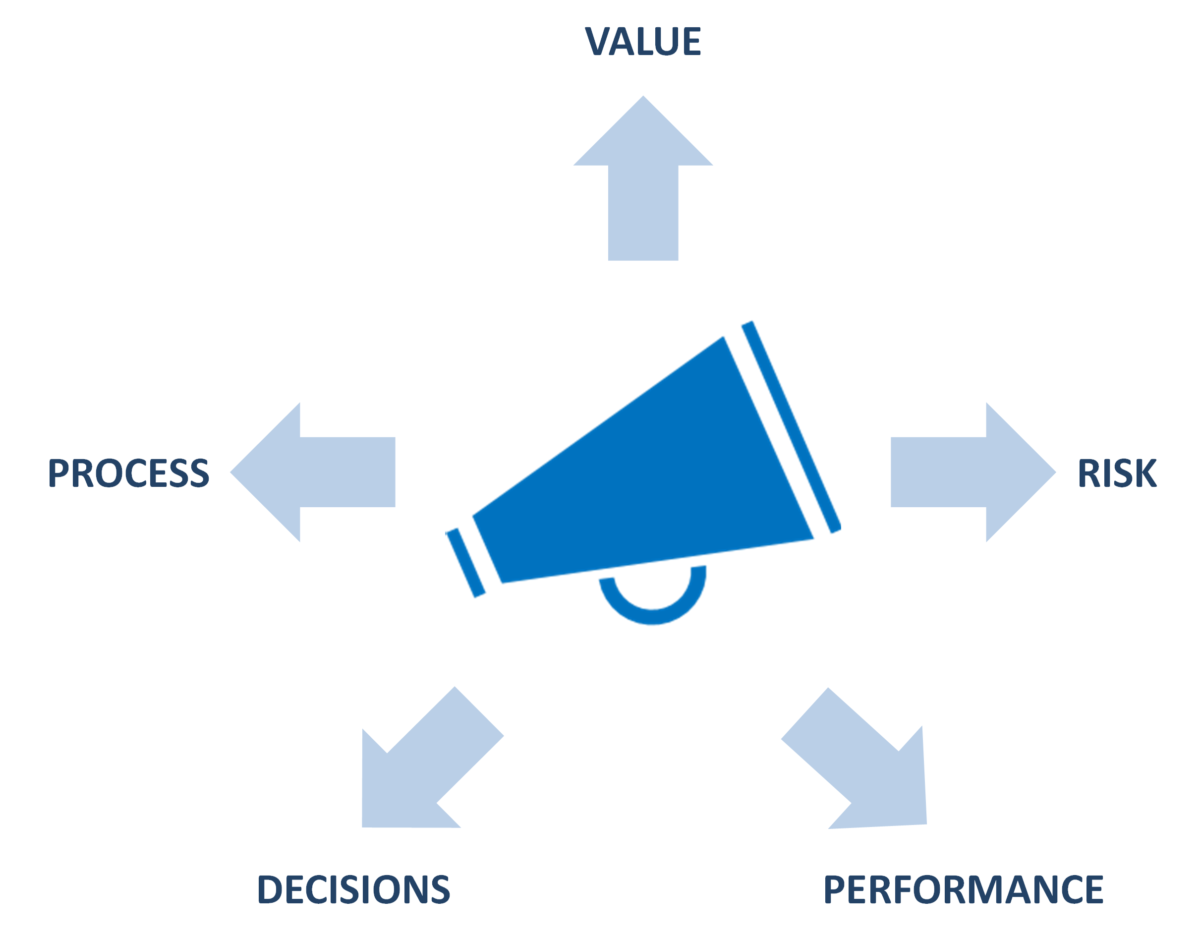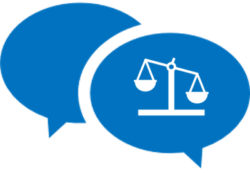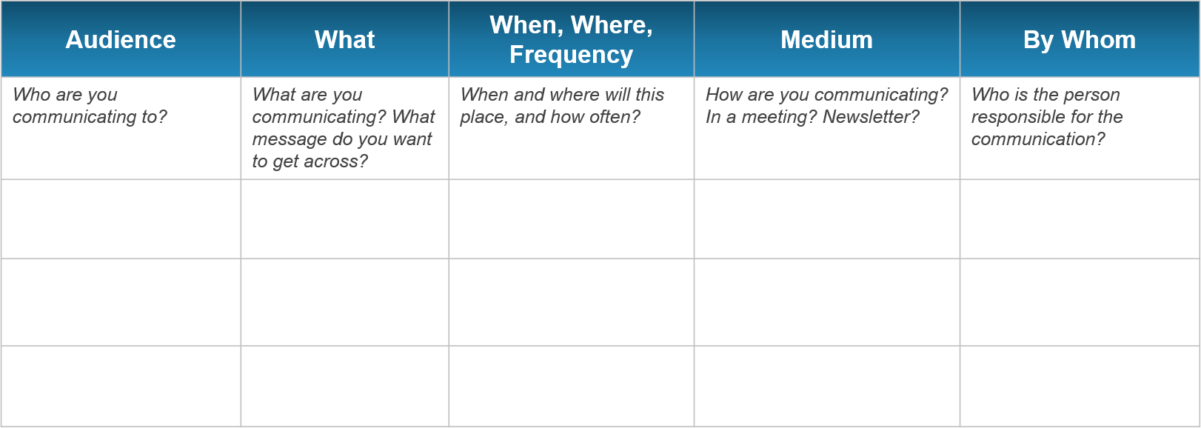Portfolio Communication-The Official Guide
Portfolio communication is the real heartbeat of project portfolio management. Strong communication keeps the organization aligned on what is most important. This thought is exemplified by Patrick Lencioni’s classic quote, “If you could get all the people in an organization rowing in the same direction, you could dominate any industry, in any market, against any competition, at any time.” That’s powerful. Since project portfolio management is all about strategic execution and maximizing business value delivery, strong portfolio communication is an essential ingredient of organizational success.
Sadly, in practice, very little attention is given to portfolio communication. According to Lencioni, communication is a basic practice that most organizations overlook. Moreover, one of the critical success factors of effective communication is to over-communicate. Employees need to hear a consistent message shared again and again by their leadership team in order to really receive and believe the message.
“If you could get all the people in an organization rowing in the same direction, you could dominate any industry, in any market, against any competition, at any time.” – Patrick Lencioni
At a fundamental level, communication is “simply the act of transferring information from one place, person or group to another” (Skillsyouneed), it is “the imparting or exchanging of information or news” (Google dictionary). Leaders need to be careful, because a one-time transmission of information can be the illusion that communication has actually occurred. As Lencioni highlights in his book, The Advantage, leaders need to be “Chief Reminding Officers” who need to over-communicate a message in order for it to be received. In other words, don’t rely on a single all-hands meeting or posting a presentation on your intranet. Ongoing portfolio communication requires real time and effort in order to keep everyone rowing in the same direction. This will also prevent any miscommunication as well as sustain the portfolio management process.
Components of Portfolio Communication
For the remainder of this post, we will dive into the five critical components of portfolio communication and share what you should be communicating to your organization and why it is important. The image below depicts the five components of portfolio communication: value, risk, performance, decisions, and process.

Each of these five areas is a critical element of successful portfolio communication:
- Value: refers to the communication of portfolio value, what work is in the portfolio, project value, and overall value delivery by the portfolio management process.
- Risk: refers to the communication of portfolio risks, portfolio risk tolerance, project interdependencies, and organizational impacts.
- Performance: involves the communication of both project and portfolio performance, the current roadmap, and project completions.
- Decisions: involves communicating governance decisions across the organization
- Process: includes the communication of how the portfolio process operates, how to initiate projects, governance and prioritization processes, etc.

Portfolio Communication: Portfolio Value
Portfolio communication begins with communicating value, especially the value that is being delivered by the active portfolio.
What Are We Doing?
The first question that needs to be answered is “what are we doing?” This is one of the most common questions, especially for organizations new to portfolio management. In order to answer this question, good portfolio tracking needs to be established, which will help you communicate all in-flight work as well as your strategic direction. Remember, the portfolio is your strategy in action.
Although a portfolio governance team should be clear on what projects are active in the portfolio, many project teams and employees may not. Without effectively communicating what the organization is working on, employees may be unclear about the strategic direction of the company. Even worse, departments may unknowingly duplicate project efforts because they are unaware that a similar initiative is in work.
One great way to communicate value is to share the strategic and portfolio roadmaps. Roadmaps graphically inform people of the timing and completion of projects. Roadmaps are a great way for sharing the strategic plans and can also be used to show an organization’s project plans.
New Projects (Business Case)
One way to provide visibility of what the organization is doing is to communicate new projects that have been approved through the Work Intake process or a governance framework. This includes sharing project business cases, which has numerous benefits. Not only do employees like to “stay in the know”, but understanding new project approvals can inform business planning, project planning, and other operational planning.
Communicating new project approvals also improves the likelihood of identifying project interdependencies. When business cases and other information is shared, it is easier for Project Managers and other team members to identify projects that could impact their own project or vice versa. There may also be cases where additional information is surfaced by people who had not been involved with the project proposal that further shapes the scope of the project in the planning phase. Having good business cases in place can also help employees better understand why the project was approved in the first place
Project Priorities
One major component of communicating portfolio value is to communicate project priorities, which conveys the relative importance of all projects. Getting people to work according to established priorities is at least as important as the leadership activity of creating a prioritized list of projects. Organizations that take the time to build a scoring model and prioritize work also need to ensure that these priorities are broadly communicated across the organization to help ensure that everyone is rowing in the same direction. I have seen organizations create a rank-ordered list of projects that was almost meaningless when it came toward addressing resource conflicts. As we covered in our post on prioritization, prioritizing projects is more than just selecting the right projects but also helps effectively allocate resources and sequence projects. Actions also need to reflect the priorities. When there are conflicts between projects, the actions taken by senior leadership to address the conflict using or not using the designated priorities will speak volumes (“actions speak louder than words”).
“Many leaders fail to overcommunicate because they get bored saying the same things over and over again. The point of leadership is to mobilize people around what is most important.” – Patrick Lencioni
Value Delivery (Benefits Realization)
When projects complete their statement of work (SOW), organizations should communicate the completion of the project and celebrate the closure of the project. Publishing a story about a successful project completion and including a picture of the project team is an extremely easy way to recognize people’s hard work and demonstrate that their work really matters. If you do not celebrate project completions, you are missing out on one of the easiest ways to boost employee morale (start doing it today!).
Project lessons learned should also be made available to educate the organization as well as inform future work. The expected value that a project was intended to achieve should be part of the celebration. In our post on benefits realization, we covered that one of the challenges of benefits realization is the weak feedback loop that often occurs after project closure. Organizations that can communicate why project benefits changed over time can build stronger business cases in the future and further increase portfolio value.
Portfolio communications should include success stories as often as possible. After I implemented a phase-gate process at a Fortune 500 company, a Project Manager told me how his project team under-estimated the cost savings of a new product. As a result of the increased cross-functional collaboration required by the new governance framework we had just initiated, the project team discovered that these changes could be applied to an entire product line resulting in an annual savings of $1,000,000. This was a huge win for the team. These types of success stories should be shared to reinforce the value being delivered by projects as well as the benefits of the portfolio management process.
Portfolio Dashboards and Reports
Finally, organizations also need to become adept at communicating the aggregate value of the portfolio by developing the right portfolio management charts. This is one step to maturity by shifting from a singular project view to an aggregate portfolio view. Highlighting portfolio investments across strategic goals, organizations, the level of portfolio performance (red, yellow, green) and the risks and issues affecting the company further stress the portfolio view of project work. PPM software such as Acuity PPM embed these features into portfolio tracking.

Portfolio Communication: Portfolio Risk
The next category of important portfolio information to share is related to portfolio risk. This includes portfolio risks, portfolio risk tolerance, project interdependencies, major project risks, and organizational change.
Portfolio Risks and Risk Tolerance
In our recent post on managing portfolio risk, we started with managing specific portfolio level risks. Communicating portfolio level risk is often at the senior leadership or executive level since it involves business impacts affecting the portfolio or the internal challenges hindering strategic execution. When introducing portfolio risk management, it often begins with communicating the types of risks potentially jeopardizing portfolio delivery. This can help educate senior leadership in forming portfolio risk management processes and escalations.
Effective portfolio risk management requires solid communication between the portfolio governance team, the PMO, other impacted senior leaders, and the executive leadership team (and possibly the Board of Directors). The risk management process needs to clearly articulate when and how to communicate portfolio risks, analysis, and recommendations to the appropriate parties. This should also be a regular agenda topic for portfolio governance team meetings.
Communicating portfolio risk tolerance is especially important for project selection. Decision makers need to understand the level of risk that the portfolio should include. Annual or quarterly portfolio risk trends should be available to decision makers to understand how risk levels have changed; and executive management should make clear what their risk tolerance expectations are, especially during annual planning.
Project Interdependencies
Project interdependencies are another element of portfolio risk that requires strong communication. The larger and more extensive the portfolio, the greater the number of dependencies between projects that exist and the harder it is to manage. Dependencies between projects add another layer of risk because the failure (or delay) of one project will often impact others. Therefore, the Portfolio Manager and PMO Director both need to maintain visibility of dependencies and foster two-way communication of these dependencies between Project Managers at project related meetings. Many organizations do not track project dependencies and fewer still actively manage the dependencies with strong communication. Failure to do so jeopardizes portfolio delivery.
Can We Absorb the Change?
In the book, Project Portfolio Management: A View from the Management Trenches, one of the questions posed is ‘can we absorb all the changes?’ From a portfolio management perspective, it is very important to understand how much change is being pushed out to the respective organizations. When there is too much change going on, employees are at a higher risk of not being able to absorb the changes, adapt to it, and accept it. This can lead to burn out, lowered morale, inability to get work done, etc.
Even when individual Project Managers do a good job of managing organizational change and effectively communicating for their respective project, they likely are not accounting for all other changes happening across the company. Without a comprehensive view of all completion dates and changes happening (monthly or quarterly), the company will not be able to gain full benefit from all the changes being implemented.
Portfolio roadmaps are useful not only for communicating portfolio value but also for monitoring the quantity and timing of changes coming to the company. Having this visibility gives the portfolio governance team a way to optimize the portfolio by adequately sequencing work so as not to overload the system with too much change at any given point in time. This is why Project Managers need to communicate up-to-date project scheduling information (with implementation dates) to the portfolio team who can then communicate with the portfolio governance team on potential conflicts.

Portfolio Communication: Project and Portfolio Performance
The communication that most commonly occurs in portfolio management is centered around performance; most specifically around project status. Although most companies may do some communication involving status reports, few also communicate portfolio performance.
Project Performance (Status Reports)
Earlier we covered the question “what are we doing?” but we also need to answer the question “how are we doing?” If projects are not performing well, then the portfolio is at risk. The third phase of the PPM lifecycle is on ‘Protecting Portfolio Value’ which is where senior leadership monitors active projects and takes action to keep projects on track. Since portfolio management is focused on value delivery, senior leaders must be responsible for protecting project investments. This is why effective communication is needed to keep senior leaders up to date on actual project performance in order to drive future actions and protect the portfolio.
Status reporting is the responsibility of the Project Manager, and a Project Management Office (PMO) needs to ensure that status data is timely, accurate, and reported on a regular cadence. The portfolio team should also work to ensure that project status is made available for cross functional teams. Disparate status reports in different SharePoint sites or in email does not provide central visibility of all project performance. Project status should not only be pushed to direct stakeholders but should be available to be pulled by other interested parties as well. This helps ensure that up-to-date information is available across the organization to support decision making and keeping project investments on track.
Portfolio Performance
Communicating portfolio performance involves aggregating all project performance data to generate portfolio level views. Portfolio performance is most relevant to senior leadership, but making this available across the PMO and project teams increases transparency and trust in the process.
We can look at aggregate portfolio health by evaluating how many projects are in a red, yellow, or green status. We can measure this by count or by cost (recommended), which will indicate how much of the portfolio budget is at risk. The example below shows how this is displayed within Acuity PPM.

Furthermore, organizations should understand the impact on strategic goals and this can easily be accomplished by looking at the number of red, yellow, and green projects for each strategic objective. Senior leadership and the portfolio governance team should monitor this information in order to take action when needed to protect the portfolio as a whole and protect the delivery of strategic projects.

Roadmaps and Project completion
Roadmaps are useful not only for communicating project value and portfolio risk, but also project and portfolio performance. Providing visibility of completion dates for projects as well as by groups of projects (such as by department, strategy, etc.) is a convenient way of tracking aggregate project scheduling performance and supports portfolio level discussions.

Portfolio Communication: Governance Decisions
Another major facet of portfolio communication is to communicate relevant portfolio decisions. Have any projects been cancelled? Communicate this carefully not only to the affected project teams but also to other parts of the organization. When companies do not have a good process for communicating governance decisions it can negatively impact the portfolio. At one organization, due to insufficient communication, some people continued to work on a cancelled project and charged time and expenses to that project which reduced the overall project budget for other initiatives.
During annual planning, some projects may be selected and others not selected. Senior leaders are often heavily invested in their proposed projects. Therefore, it is important to provide timely and accurate information to stakeholders and project teams about current approval decisions..
Communicating portfolio decisions is not limited to approvals and cancellations. Throughout project execution, there can be new budget requests and scope changes. These decisions should be captured and made available to the right stakeholders for later review. Be sure to send out key meeting notes in a timely way from important portfolio meetings such as: portfolio review meetings, project status meetings, gate review meetings, and other governance meetings.
Communicate How You Use Project and Portfolio Data
Good quality project and portfolio data is the fuel that runs the portfolio engine. Bad data will clog the engine; good data will help the organization sail forward. Timely and accurate data represents a major facet of successfully implementing project portfolio management (PPM). Part of the up-front challenge involves collecting good quality data and then maintaining it. Data quality is never perfect at the and collecting data takes time and effort. That’s why I often say data collection is not free, any data collected and not used is an organization drain on resources. This is why it is imperative for senior leaders to communicate how they are using portfolio data. Otherwise, employees will ask “is this data being used?” and if they feel like it is going back into the black box, data collection will be even harder in the future and data quality will suffer.
Two classic examples of portfolio data collection involve time tracking and resource capacity and utilization. At some companies, people may be required to enter time tracking data in more than one place. Even when a standard system is in place, getting hounded for more granular time entry is not pleasant. This weekly chore wears on people, prompting people to ask “who uses this data and how is it used.” Without a satisfactory answer, people will be more prone to enter as little as possible to complete the task. The same goes for resource forecasts. I worked at one company that collected resource forecasts from hundreds of people. I had to hound resource managers to keep the data fresh and accurate. Some complied and others just put if off for later because they saw no value in it. This would have been an ideal time for senior leadership to communicate why it was important to forecast resource effort and explain how it was actually being used to make better decisions.
This brings us to a virtuous cycle that senior leaders can use to improve portfolio data quality.

- Use the data: when leadership uses actual portfolio data, they will better understand what data is truly needed for higher quality decision making. Moreover, once the data gets used, any data quality gaps will be surfaced.
- Communicate that the data is being used: communicating that the data is being used is necessary for reinforcing the importance of the portfolio processes; it helps project teams buy into the process and cooperate with it. Yet, senior leadership needs to take one more step—demonstrate how the data is being used.
- Demonstrate how the data is being used: communicating that all of that portfolio data is actually being used, but demonstrating that it is making a difference with improved decision making is another. Explain how this new data has improved governance decision making; doing so with stories is even better.
- Data quality improves: based on parts 1-3, data quality should in fact improve. When people understand the process and its value, it is no longer a black box and employees will cooperate.
- Better decision making: with higher quality data comes better decision making.
A little extra leadership communication can go a long way in improving portfolio management.

Portfolio Communication: The Portfolio Management Process
The last major component of portfolio communication is on communicating how portfolio processes work. This is primarily directed at non-management and is important for several reasons. If you do not communicate how your portfolio management process is set up, employees will not know how to interact with it. At many companies, portfolio management can seem like a black box.

Years ago while working at the Boeing Company, the departmental Communication Manager and I went on an extensive roadshow to over 40 teams to share with them how the portfolio management process worked. There was skepticism with how projects were selected, especially since they believed that a lot of good ideas had been shelved in favor of inferior projects. In a classic Harvard Business Review article, W. Chan Kim and Renee Mauborgne (co-authors of Blue Ocean Strategy) link trust, idea sharing, and corporate performance together with the concept of ‘fair process’. Their central finding is that employees will commit to a manager’s decision—even one they disagree with—if they believe that the process the manager used to make the decision was fair. This roadshow was a career highlight because it confirmed what this article was saying. I had a chance to interact with people who were impacted by the projects in the portfolio but who did not understand how the process worked. After explaining how portfolio management worked, they agreed that there was a fair process for reviewing and approving work and they felt more confident in leadership decision making at the portfolio level.
Here are several portfolio management processes worth communicating:
- Intake process: as we discussed in our in-depth post on work intake, it is critical that organizations communicate how the work intake process operates so that employees can systematically provide new ideas. Without this intake communication, new ideas can enter the portfolio with inconsistent quality which can compromise portfolio value. When people understand how to submit new ideas they will be more likely to work within the process and not go around it.
- Governance process: people want to know who the decision makers are and what their roles and responsibilities are. As we mentioned before, without clearly explaining how the governance process works, people will be skeptical and it will feel like a black box. This again points to the accountability framework by showing who is accountable for portfolio results. Another component of communicating portfolio governance is how conflicts get shared, escalated (as needed) and resolved. This will make it more efficient to address risks and issues affecting the portfolio.
- Prioritization process: we covered at the beginning the importance of communicating project priorities, but it is just as important to explain the prioritization process. This will reinforce the notion that a fair process exists and priorities are not based on emotions. When people buy in to how projects are prioritized, they are more likely to work according to those priorities.
- Resource management (capacity planning): perhaps the most challenging component of project portfolio management is resource capacity planning. Organizations that have developed a capacity planning process must ensure that Project Managers, Scrum Masters, Product Owners, etc. all understand how resources are assigned to projects and how their utilization is monitored. Otherwise, resource assignments may go under the radar, and up-to-date utilization will be under-reported.
- Portfolio meetings: important portfolio meetings such as portfolio governance meetings, portfolio review meetings, status meetings, and gate reviews are great forums for sharing information and are places where decisions get made. Informing people of the purpose of these meetings and when they take place will improve the information flow within the organization and reduce the risk that a meeting gets hijacked by an off-topic agenda item.
Develop Your Portfolio Management Communication Plan
So far we have covered the five core elements of portfolio content that needs to be communicated across the organization. In this last section we will finish with developing a portfolio communication plan. After reading how much information needs to be communicated out to the organization, you should be impressed with the importance of portfolio communication. It is now paramount that you develop a formal communication plan, which is part of your communication strategy.
A simple communication plan will have a few basic elements:
- Audience – who is the audience? This very much involves stakeholder analysis. As we discussed, portfolio management can affect most or all of an organization. I prefer to start with analyzing my audience so I can define what communication each group needs. Based on the audience, you can tailor your message to them. Be sure you speak the same “language” as they do; learn to speak the language of business as well as the language of project management appropriately to your audience.
- Content – what are you communicating? What message do you want to convey? Why is it important? We have covered this in great detail above.
- Cadence – what is the place, timing, and frequency for communication?
- Medium – how is the communication being delivered? The means for delivering information is very important. As we mentioned earlier, simply sharing information once (a push communication such as an email to 100’s of recipients) creates the illusion that communication has occurred. What is critical is to ensure that the right method is used to get the message across. In some cases, interactive methods such as meetings are invaluable. One email to the entire department at Boeing could have replaced 40 time-intensive roadshow meetings, but it would never have accomplished the same results. In other cases, an email push is effective and necessary. In addition, let people pull information from your PPM system or SharePoint site as much as possible .
- Messenger – who will conduct the communication? I would suggest that a Portfolio Manager is best equipped to manage most of the portfolio related communication. This person (or persons) will be in most or all of the portfolio-related meetings, is involved with portfolio processes, and interacts with the project teams. Some communication needs to be shared by a PMO Director or an Executive on the governance team, but most of the communication can be handled by a Portfolio Manager. When Executives are responsible for critical communication, repetition of the message is likely necessary. “Messaging is not so much an intellectual process as an emotional one….Employees are not analyzing what leaders are saying based solely on whether it is intellectually novel or compelling, but more than anything else on whether they believe the leaders are serious, authentic, and committed to what they are saying. Many leaders fail to overcommunicate because they get bored saying the same things over and over again. The point of leadership is to mobilize people around what is most important.” In the near future, we believe that Artificial Intelligence and Machine Learning can greatly improve portfolio communications.
**PRO TIP: if your organization has a Communication focal – work with them to get updates published in newsletters and quarterly updates. This will make your job of communication even easier.
VIDEO: The Importance of Portfolio Communication
The image below provides a simple communication matrix that you can use to plan your portfolio communication.

The Relationship Between Project Communication and Portfolio Communication
In another post, we covered many of the important aspects of project communication and how it leads to successful outcomes. Project communication does play an important role within the overarching portfolio communication particularly as it relates to performance, risks, and value. Without good project performance communication (which includes status reports), it is difficult to provide timely portfolio performance updates. Weak project communication requires more work of the PMO and/or a Portfolio Manager to pull this information and summarize it at the portfolio level. Weak project communication leads to delayed portfolio communication. Project Managers also need to communicate significant project risks, which can sometimes lead to portfolio risks. Inadequate risk communication can leave the portfolio exposed and the portfolio governance team blindsided if those risks are realized as issues. Finally, Project Managers need to learn how to communicate project value. Projects are executed in order to deliver value (not simply to be on time, on budget, and within scope). Project Managers will do well to hone their project’s “elevator pitch” to quickly explain the value of that project to the organization.
In summary, portfolio communications is the real heartbeat of project portfolio management that keeps an organization focused on what is most important. It will help your employees all row in the same direction – that’s critical for successful strategic execution. Communication does not happen by itself – it needs to be planned and executed like any other business process. Strong portfolio communication is an essential ingredient of organization success; failure to communicate can impede your success.
We can help you develop a portfolio communication plan that is solid and effective. To learn more, click on the button below.
Tim is a project and portfolio management consultant with over 15 years of experience working with the Fortune 500. He is an expert in maturity-based PPM and helps PMO Leaders build and improve their PMO to unlock more value for their company. He is one of the original PfMP’s (Portfolio Management Professionals) and a public speaker at business conferences and PMI events.
Lencioni, Patrick, The Advantage, Jossey-Bass, 2012
Lencioni, Patrick, The Five Dysfunctions of a Team: A Leadership Fable, Jossey-Bass, 2002
[activecampaign form=3]
What is portfolio communication?
Portfolio communication is the real heartbeat of project portfolio management because it communicates both strategic and tactical information about the project portfolio.
Why is portfolio communication important?
Project portfolio management is about strategic execution and maximizing business value delivery. Strong portfolio communication is an essential ingredient of organization success because it keeps the organization aligned on what is most important.
What portfolio information should be shared with the organization?
There are several key elements of portfolio communicatation that PMO's and portfolio leaders are responsible for: portfolio value (both project and portfolio related), portfolio risk (involving portfolio level risks, changes to the organization, and other potential conflicts), project and portfolio performance, portfolio governance decisions, and current portfolio processes.
What is a portfolio communication plan?
A portfolio communication plan assesses the key stakeholders involved with the portfolio management process and identifies what information and messages need to be shared with each group. Since portfolio management is both strategic and tactical, the portfolio communication plan should address communication to executive leadership as well as across the company to employees.
Never miss an Acuity PPM article
Don't take our word, listen to what others are saying:
"I find value in all of your articles."
"Your articles are interesting and I am sharing them with my team who have limited project knowledge. They are very useful."


